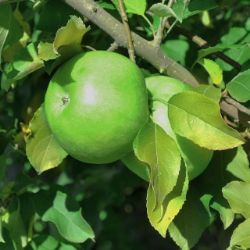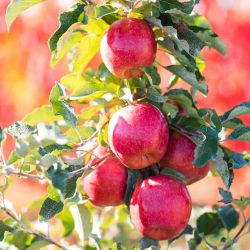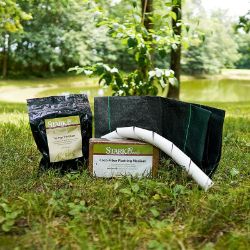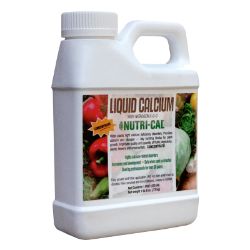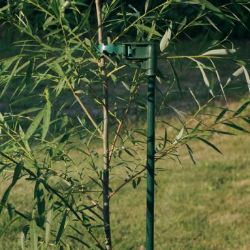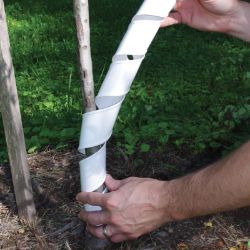Fertilizing Apple Trees
Fertilizing is an excellent way to replenish the nutrients in your soil, especially nitrogen. Nitrogen encourages green vegetative growth, which is exactly what you want to promote before your apple tree reaches its fruit-bearing years.
Always test your soil prior to applying any fertilizers. Different soils can have varying amounts of native elements needed to support apple tree health and development. If you discover your soil lacks any necessary nutrients (nitrogen, phosphates, potash, etc.), be sure to choose a fertilizer that supplements the soil’s nutrient deficiency.
Get to know your soil and discover the importance of soil testing prior to making any changes.
NOTE: This is part 6 in a series of 11 articles. For a complete background on how to grow apple trees, we recommend starting from the beginning.
Fertilizer Information
- Fertilizers – both synthetic and organic (naturally derived) – are soil amendments labeled with a “guaranteed analysis” of nutrients like Nitrogen (N), Phosphate (P), and Potash (K).
- Alternately, there are organic soil amendments, like compost and aged/rotted manure. They are used like fertilizers, but they are not technically fertilizers. You can make your own organic soil amendments like compost out of food or garden scraps, or even find compost, manure, and other organic soil amendments from a trusted local source. While these help add nutrients to the soil to support your apple trees, they will not have a “guaranteed analysis” value.
- In general, apple trees thrive when macronutrients like Nitrogen (N), Phosphorous (P), and Potassium (K) are present. Nitrogen helps encourage vegetative growth (leaves and branches). Phosphorus encourages root- and blossom-development. Potassium/Potash is responsible for the efficacy of the apple tree’s natural disease-resistance and systems supporting its overall health. Our water-soluble Stark® Tre-Pep® Fertilizer is specially formulated for use on young apple trees (and all young fruit trees), since its composition supplements and provides the nutrients these young trees take-in during their first years in the ground.
Apple varieties that are “light feeders” on Nitrogen:
- apples that ripen early
- soft-flesh apples
- apples mainly for fresh-eating
Examples: Cortland Apple, Ginger Gold Apple, Golden Delicious Apple, Gravenstein Apple, Jonagold Apple, Macoun Apple, McIntosh Apple, Stark® Jon-A-Red® Jonathan Apple
Apple varieties that are “heavy feeders” on Nitrogen:
- apples with firm flesh
- soft-flesh apples for cooking, sauces, etc.
Examples: Empire Apple, Granny Smith Apple, Honeycrisp Apple, Liberty Apple, Red Stayman Winesap Apple, Rhode Island Greening Apple, Stark® BraeStar™ Apple, Starkrimson® Red Delicious Apple, Starkspur® Red Rome Beauty Apple, York Imperial Apple, Fuji apple trees, and Gala apple trees.
Apple trees and their fruit also benefit from the availability of micronutrients like Calcium. Honeycrisp apple trees in particular tend to require more calcium than other varieties, so, to avoid diminished tree- and fruit-quality due to calcium deficiency, it is wise to apply (either as a soil additive or foliar application during the growing season) a liquid calcium-supplement like Nutri-Cal®.
When to Fertilize Apple Trees
- In nutrient-rich soil, you can withhold using fertilizers until your apple trees begin bearing fruit (average: 2-4 years). If your new apple trees fail to put on an average of 8- to 12-inches of new green growth during the growing season, consider fertilizing starting the following spring.
- Typically, fertilizers are used during the growing season, as soon as the soil is workable in early spring and stopping by July 1*. For any specific fertilizer application instructions, always refer to the information printed on your product’s label. Be mindful that local advisories on fertilizing may be in effect during different times of year. For the sake of your local environment, please adhere to these restrictions.
- After your apple trees start bearing fruit, their uptake of Nitrogen increases. In response to this, an application of high-nitrogen fertilizer is recommended once in early spring for fruit-bearing apple trees. One example of a high-nitrogen fertilizer is our Stark® Orchard Fertilizer granules.
*To prevent the chance of injury as the growing season winds down, do not fertilize past July 1st.
Read more about fertilizing:

















